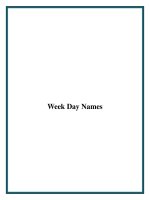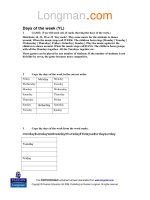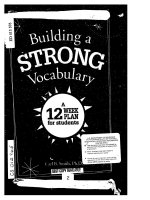E9 Week 6
Bạn đang xem bản rút gọn của tài liệu. Xem và tải ngay bản đầy đủ của tài liệu tại đây (270.02 KB, 4 trang )
<span class='text_page_counter'>(1)</span>Week: 6 Period: 11. Date of preparing: 27/ 09/ 2016 Date of teaching: 29/ 09/ 2016. UNIT 2: CLOTHING Lesson 5: WRITE I. OBJECTIVES: Teaching aims: By the end of lesson Ss will be able to write an exposition, presenting one side of an argument. II. PREPARATIONS: Pictures, book III. PROCEDURES: *Checking attendance (1’): - 9A1:………………………………………………… - 9A2:………………………………............................ Teacher’s activities 1. Warm - up (5’) - Have Ss play a game: write words for these clothes.. 2. Pre - writing (10’) - Have Ss rearrange the passage into the correct order. - Have Ss read the format of how to present one side of an argument. - Explain the format. 1. Introduction: My opinion is............ I think....................... 2. Series of argument Firstly,................... Secondly,............... Finally,.................. 3. Conclusion Therefore,............. In conclusion,...... Students’ activities Play game.. - Rearrange the passage - Read the outline A - Pay attention the format.
<span class='text_page_counter'>(2)</span> 3. While - writing (22’) - Have Ss read the outline B and write a paragraph to - Use the outline B to write a support the argument that students should wear casual paragraph. clothes -Test 15’: Use the outline B to write an argument. - Ask Ss to work in individual. - Work in individual. * Suggested ideas: My opinion is that secondary school students should wear casual clothes. Firstly, casual clothes make Ss fell comfortable. Secondly, wearing casual clothes give Ss freedom of choice about size, colors and fashions. Thirdly, casual clothes make Ss fell confident when they are in their favorite clothes. Finally, casual clothes make school more colorful and lively. In conclusion, secondary school students should wear casual clothes .Wearing casual clothes is convenient, comfortable and fun. 4. Post - writing (5’) - Have T read some Ss writing and comment. - Listen and take note. - Correct mistake. - Correct the mistakes. 5. Homework (2’) - Write the paragraph on their notebook Take note. - Prepare next lesson: Unit 2: Language Focus/ p.19 IV. COMMENTS: ........................................................................................................................................................... ........................................................................................................................................................... __________________________________ _______________________________ Week: 6 Period: 12. Date of preparing: 01/ 10/ 2016 Date of teaching: 03/ 10/ 2016. UNIT 2: CLOTHING Lesson 6: LANGUAGE FOCUS I. OBJECTIVES: Teaching aims: By the end of the lesson, Ss will be able to know how to use the present perfect with ALREADY and YET, distinguish the difference in using the past simple and the present perfect tense, review the passive forms of the present perfect, simple present, simple past, and simple future, modal auxiliaries. II. PREPARATIONS: Book III. PROCEDURES: *Checking attendance (1’): - 9A1:………………………………………………… - 9A2:……………………………….............................
<span class='text_page_counter'>(3)</span> Teacher’s activities 1. Warm - up (5’) - Chat with Ss, ask and answer questions part 3/ p.20 + Have you ever read a comic book? + When did you last read one? + Have you ever been in Singapore? 2. Exercises (35’) a. Exercise 1: (7’) Present prefect tense - Have Ss review form of present perfect tense.. Students’ activities - Whole class. + Yes, I have. + This morning. + No, I haven’t. - Review.. Have / Has + V (ed/ 3) For + a period of time Since + a point of time - Ask Ss to practice the dialogue. + It’s Lan, my old friends. + How long has Nga known her friend? She has known her friend for six years. + Has Nga seen her recently? No, she has not seen her friend since 2003. - Call some pairs to practice the dialogue. b. Exercise 2: (8’) Present perfect tense with Already, Yet - Give Ss the use and the position of already and yet in the sentence + ALREADY: is used in affirmative sentences. Position: mid sentence + YET: is used in the negative sentences and questions Position: end of the sentence - Set the scene: You and your friend are visiting HCM City. - Ask Ss to talk about things they done, they haven’t done. in pairs. - Call some pairs to practice. d. Exercise 4, 5: (20’) Passive forms - Give example: They sell jeans all over the world. They are sold all over the world. - Have Ss give the passive voice form: Tenses Be + past participle 1. Simple present is/are/am+ V(ed,3) 2. Simple past was/were+ V(ed,3) 3. Present perfect have/has+ been + V(ed,3) 4. Modal verbs modal verbs + be +. - Work in pairs, make similar dialogues.. - Practice the dialogue. - Listen and write.. - Listen. - Work in pairs. - Practice. - Change into passive voice. - Take note..
<span class='text_page_counter'>(4)</span> V(ed,3) - Have Ss do exercise 4-5/page 21 in groups. - Get feedback.. - Group work. - Give the answer.. 3. Consolidation: (2’) - Ask Ss to review structures of tenses and passive forms.. Review.. 4. Homework: (2’) - Ask Ss to review structure and grammar from Unit 1 – 2. Take note Prepare for: Forty – Five minute Test IV. COMMENTS: ........................................................................................................................................................... ........................................................................................................................................................... ___________________________ ____________________________.
<span class='text_page_counter'>(5)</span>









